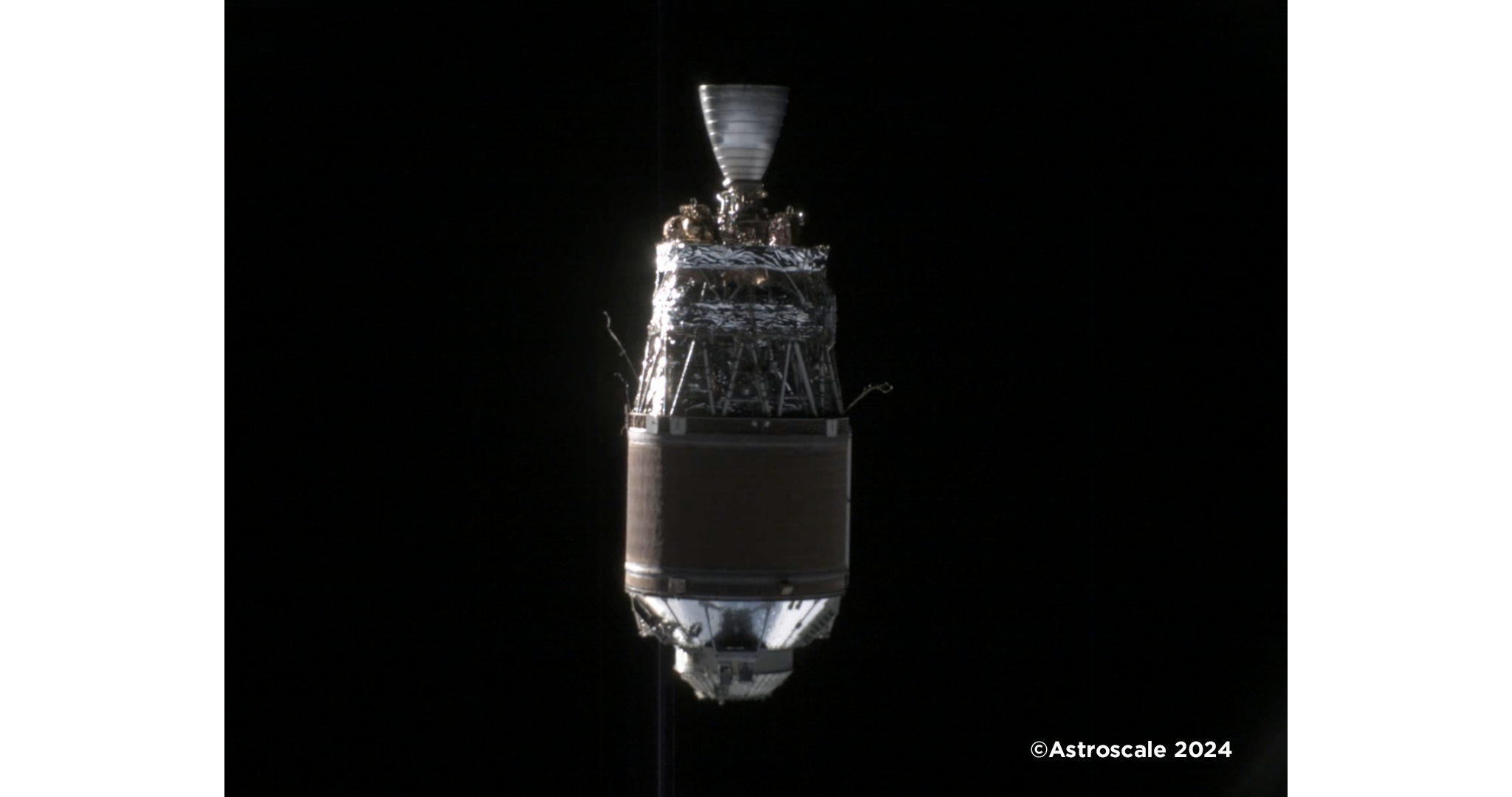CRD2 Phase I / ADRAS-J update: “fixed-point observation” images of space debris have been released
June 14, 2024 (JST)
Japan Aerospace Exploration Agency (JAXA)
The Japan Aerospace Exploration Agency (JAXA) has advanced the Commercial Removal of Debris Demonstration (CRD2) (*1) Phase I project, under which the demonstration satellite Astroscale’s ADRAS-J (*2) has successfully captured images of space debris, a non-cooperative target (*3), through "fixed-point observation." These images have been released by Astroscale Japan Inc.

Figure 1 : One of the images of the target space debris taken during the "fixed-point observation" (H-IIA upper stage, which launched Greenhouse Gases Observing Satellite (GOSAT), also known as Ibuki in 2009, H2A R/B, International Designator: 2009-002J, Catalog Number: 33500, the bottom of the image is toward the nadir direction).
The "fixed-point observation service" is one of four "services" (*4) that JAXA requires for Phase I of CRD2. This service involves observing the target debris from a fixed point in the target's orbital coordinate system (*5) and providing continuous images of the target with the required image quality and data volume.
On May 23, Astroscale Japan Inc. successfully carried out the "fixed-point observation service" with ADRAS-J, maintaining a distance of approximately 50 meters from the target while adhering to JAXA's safety requirements (JERG-2-026 Safety Standards for On-Orbit Servicing Missions (*6)). This resulted in the successful capture of images as shown in Figure 1.
The specifications for the "fixed-point observation service" are designed to obtain sufficient quality and data volume to capture images that reveal the motion, damage, and degradation of long-orbiting debris, which is globally scarce information. In addition, these specifications have been carefully developed based on JAXA's technical expertise, ensuring their feasibility, and taking into account that by providing the service, the contracted company will be able to acquire Rendezvous and Proximity Operations (RPO) technologies applicable to a wide range of on-orbit services, including active debris removal.
The successful and safe performance of the service by Astroscale's ADRAS-J is a steady step towards achieving the two objectives of CRD2: acquiring debris removal technology to improve the increasingly serious space debris problem and enhancing the competitiveness of Japanese companies in the on-orbit services market. The CRD2 has achieved two of its objectives.
The images obtained confirm that the movement of the target space debris is in a vertical attitude along the nadir direction, with hardly any rotation around its long axis. It was also confirmed that the debris shows no significant damage. The string-like objects observed on either side of the body are presumed to be surface protection tapes which are also seen in the launch operation images. These observations provide crucial insights for the capture operation in CRD2 Phase II.
Astroscale Japan Inc. will continue operating ADRAS-J, carrying out a "Fly-around observation service" and "Astroscale missions," and eventually performing a "mission termination service" (transitioning to a safe orbit to avoid collision with the target). JAXA has provided extensive technical advice, testing facilities, and research intellectual property, focusing on on-orbit rendezvous, supporting ADRAS-J's development and operation. Moving forward, JAXA will continue to provide technical support for ADRAS-J operations and conduct a detailed analysis of the obtained images.
*1: Commercial Removal of Debris Demonstration (CRD2)
The Commercial Removal of Debris Demonstration (CRD2) is a new initiative by JAXA to acquire active debris removal technology to address the escalating space debris problem and support the commercial activities of the Japanese companies. Astroscale Japan Inc. has been selected as the contract partner for Phase I of the CRD2. In this project, JAXA provides technical advice, test facilities, intellectual properties of research results to support the selected companies.
CRD2 web: https://www.kenkai.jaxa.jp/eng/crd2/project/
*2: ADRAS-J
CRD2 Phase I demonstration satellite developed, owned and operated by Astroscale Japan Inc.
*3: Non-cooperative target
A non-cooperative target refers to a space object that lacks certain features and equipment, such as attitude control functions, communication capabilities, GPS receivers, laser reflectors, image processing markers, and docking mechanisms, which are essential for facilitating its approach or capture by another spacecraft. The absence of these elements significantly increases the technical challenges involved in approaching or capturing such targets, especially when compared to objects that are equipped with these features, like the International Space Station.
*4: JAXA's Required Services in CRD2 Phase I
The four required services are "Rendezvous performance reporting service," "Fixed-point observation service," "Fly-around observation service," and "Mission termination service."
CRD2 web: https://www.kenkai.jaxa.jp/eng/crd2/project/
*5: Orbital Coordinate System
A Cartesian coordinate system with the centre of gravity of an orbiting object as the origin and consisting of three axes: the nadir direction, the direction perpendicular to the orbital plane and the direction that is right-handed with them (approximately the direction of velocity in near-circular orbits).
*6: JERG-2-026 Safety Standard for On-Orbit Servicing Missions
The standard outlines the basic requirements that should be taken into consideration for service satellites to avoid collisions that could lead to significant debris generation or the service satellite becoming debris itself during operations involving close approach, contact, or docking with other client satellites or objects.